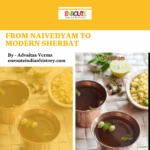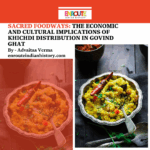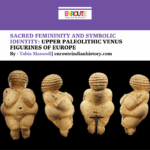The Woman In The Kitchen: The Life and Times of Pragyasundari Debi
- EIH User
- May 12, 2023
Article Written By EIH Researcher And Writer
Neena Ghosh
How many times have we come back home and rushed into the kitchen to taste the plethora of delicacies that our mothers and grandmothers have cooked for us? Summer holidays were usually replete with memories of our grandmothers preparing our favourite sweets, curries and pickles. Today they are all memories; memories which are coloured with nostalgia but forgotten or worse still neglected. When these memories come back to us in flashes suddenly, we remember the love and care of these maternal forces but then there is a perennial problem in the way in which we reminisce about those moments.
The problem is that while there is no dearth of affection for these figures in our lives we do not for once acknowledge their talent and creativity.The point is that it is always presumed that the kitchen is the world of a woman. Willy-nilly, a woman has to enter the kitchen. This article is a tribute to the contribution of Pragyasundari Debi, the niece of Rabindranath Tagore, who redefined Bengali cuisine and gave it her own cult status. In our effort we would simply not adulate this character but also for once recognise and consider the arduous efforts that women across time and space devoted to the kitchen.
Any discussion on Pragyasundari Debi would be futile if she is not placed in a wider spectrum of history. Born into the illustrious and culturally effervescent family of the Tagores, Pragya’s father was Hemendranath Tagore, who straddled both the worlds of science and spirituality. Her mother Nripomayee was a self-taught artist. She grew amongst strong women who traversed the worlds of tradition and modernity with ease. Her distinguished ancestry were ushering in modernity in Bengal and in this process Pragya’s contribution was no less significant.
Pragya lived at a time when the Bengali society was being regenerated from its dilapidated shape. Although this period has been widely hailed as the Bengal Renaissance, the term is considered to be problematic by historians today. However instead of dwelling into the controversies of historiography, we would like to focus on the journey of Pragyasundari in this period of cultural effervescence.
The degenerated society could only be reinvigorated with education and that had to be at par with the values of the land. This education in turn led to the birth of a new woman, the Bhadramahila. The curricula for women went through different twists and turns. The revisionists envisioned women to have the knowledge of cooking and culinary skills. Schools such as the Utterparah Hitakari Sabha had cooking listed out as a subject. In fact a cooking prize was also awarded by the Mahila Bangla Sammilani in the year 1893. Cookery books also began to be published from the late nineteenth century. The middle-class Bengalis i.e. the ones who constituted the intelligentsia argued that the inclusion of cooking was in tandem with what British women had on their curriculum as well. Albeit the knowledge of cooking however stemmed from the man itself.
A woman cooked within the premises of her household and this included her husband’s favourite recipes. But the general cooking in the household was carried out by professional cooks, usually Brahmins. This was, in other words, the private and public world of cooking. Yet this process of commercialisation of cooking was soon ridiculed and mocked by contemporaneous literature. In the derision these writers shifted their attention to the woman, the lady of the household (Grihini). The lady resembled Goddess Annapoorna (the Hindu deity for Food and Nourishment); hence she would care for her family and provide them with food. This process of deification while raising the woman on a pedestal also brought in connotations. The obvious was the devaluation of labour; when a hired cook cooked he was remunerated; the lady of the house however had no such independence. However, the silver lining in this process was the presence of women like Pragyasundari who, through their penchant for cooking, depicted the process like an art.
Pragya was not just cooking and ensuring that everyone had a taste of her delicacies. She was also documenting the recipes. As opines Utsa Ray, Pragya equated the documentation of recipes as an art. Indeed there were vociferous and quite lively debates around recipes and it had an academic dimension. Her recipe compilation later acquired the form of a book titled, Amish o Niramish Ahar (Non-vegetarian and Vegetarian food items). In doing so Pragya merged the public and private worlds of cooking. Pragya curated a massive list of recipes in which she combined the age-old techniques of her foremothers and her own experience within the kitchen As notes Chitra Deb, “Her recipes were mostly gleaned from rural Bengali life. The synonyms used in the Bengali kitchen were alsotypical of Bengali women’s own language,”. Her cooking style was influenced by the colonial period as well. Her menu cards or kramanikas enlisted a number of European gastronomical delights including the likes of breadcrutons, asparagus sandwich, cucumber sandwich, blackmange and others. She is even known to have edited a food journal called Punya from 1897 onwards.
She was known for making delicacies with the most absurd ingredients. For her uncle Rabindranath’s fiftieth birth anniversary, she concocted a dessert called Kavi Smabardhana Barfi. While it was filled with cashews, raisins and pistachios, and tasted delicious, the guests were astounded that it was made with cauliflower. Her recipes also included Chhana’r Polao, a rice dish made with fragrant Basmati rice, dried fruits like almonds, raisins and pistachios (an obvious Persian influence) and Indian cottage cheese, chhana. There is also the unheard Bhaat’er Kofta, or deep fried rice balls. This dish was influenced by Italian arancini. While the inside of the dish is creamy and flavourful, the outer crust is made with yoghurt and semolina (sooji). There are several other dishes that she is credited with.
Pragya was married to Lakshminath Bezboroa, an Assamese author who encouraged her to continue with the task of documenting recipes. Pragya even wrote an Assamese cookbook as well. It was titled, Rondha Bora. Her last book was called Jarok. This book was a compilation of pickles and preserves. Another unique aspect of her personality and cooking life was naming her recipes after her loved family members. Hence in her huge rucksack of recipes lay items called, Dwarkanath Phirnipillau (named after her great-grandfather) and Surabhi Kheer (named after her deceased daughter). There were also times when she would compile European dishes with oriental spices. Therefore to custard sauce she would add spices like nutmeg and clove. There was also the generous use of ghee or clarified butter to her dishes. Her cooking style thus combined the best of the East and West and made the food palatable to the Indian tastebud.
Feminist knowledge was deeply embedded in her books. She therefore documents the contemporary prices of commodities. One ser of rohu fish was sold for three or four annas and an egg would cost one paisa. There were also details on the list of spices that could be used for making pan or betel leaf. It also devoted a sizable section to feminine knowledge on childrens’ ailments, diet for patients and on overall cleanliness in the kitchen.
The public world of gastronomy dominated by men met with a subtle change. This change while not directly challenging the position of a man established the woman as another agent of change. Pragyasundari Debi therefore straddled both these worlds with extreme adroitness. Her recipes are also an alibi of the poetic sense which was bestowed on her genetically. These works ratify that women can and do bring tremendous change in the world. Even when women are involved in domestic chores of any kind, they make history. Pragyasundari and her beautiful compendium of recipes is a living testimony to that. And how does it help us reconstruct her? Well for the uninitiated, she makes the watchwords- “Private is political” rather clear. Slowly and silently she challenges patriarchy, misogyny and gender biases. She has through her contributions made an indelible mark on Herstory. Professor Ruby Lal had at a very different juncture prophetically remarked, “Erase a woman out of power and she will make her way through History”. Pragyasundari’s life and legacy is a homage to these wise words. Today when so many girls desire to become chefs and work in professional kitchens, they must revisit this powerful lady from nineteenth century Bengal.
References
- Borthwick, Meredith. The changing role of women in Bengal, 1849-1905. Vol. 2088. Princeton University Press, 2015.
- Ray, Utsa. “Aestheticizing labour: an affective discourse of cooking in colonial Bengal.” South Asian History and Culture 1.1 (2009): 60-70.
- Bhattacharya, Paushali. “From the Kitchen of Rabindranath Tagore: Tracing the Bengal Renaissance in the Evolution of Culinary Arts.”
- Deb, Chitra. Women of the Tagore household. Penguin UK, 2010.
- Bose, Indrajit. “Culinary Chroniclers of Bengal: Pioneering Bengali Women’s Cookbooks.” Proceeding of.
- https://www.getbengal.com/details/pragyasundari-devi-turned-jorasanko-thakurbari-kitchen-to-a-centre-of-liberal-feminism
- https://www.bongeats.com/recipe/chhanar-polao

















